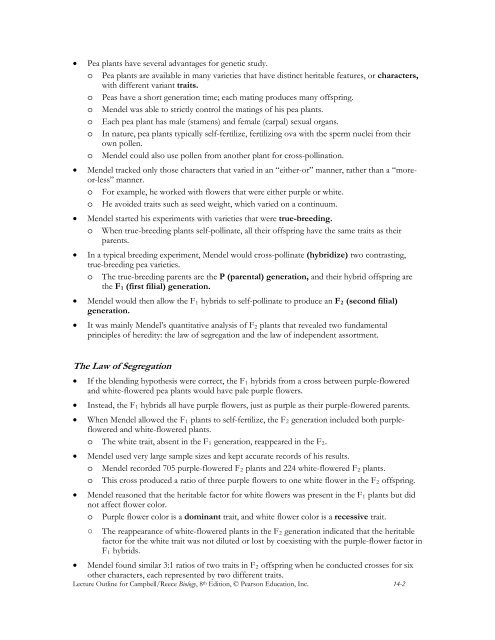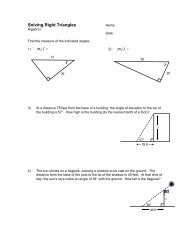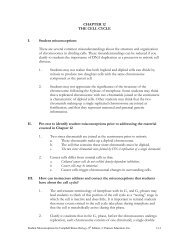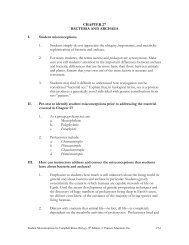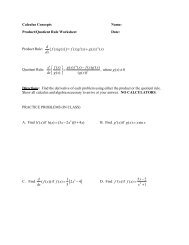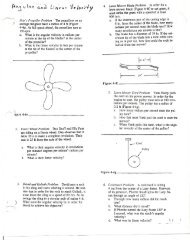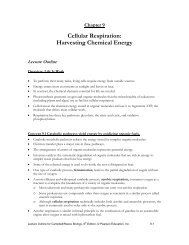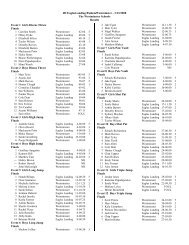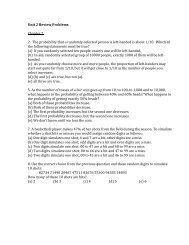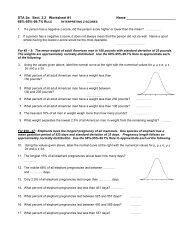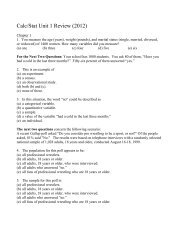CHAPTER 14 MENDEL AND THE GENE IDEA - Hancock High School
CHAPTER 14 MENDEL AND THE GENE IDEA - Hancock High School
CHAPTER 14 MENDEL AND THE GENE IDEA - Hancock High School
Create successful ePaper yourself
Turn your PDF publications into a flip-book with our unique Google optimized e-Paper software.
Pea plants have several advantages for genetic study.<br />
o Pea plants are available in many varieties that have distinct heritable features, or characters,<br />
with different variant traits.<br />
o Peas have a short generation time; each mating produces many offspring.<br />
o Mendel was able to strictly control the matings of his pea plants.<br />
o Each pea plant has male (stamens) and female (carpal) sexual organs.<br />
o In nature, pea plants typically self-fertilize, fertilizing ova with the sperm nuclei from their<br />
own pollen.<br />
o Mendel could also use pollen from another plant for cross-pollination.<br />
Mendel tracked only those characters that varied in an “either-or” manner, rather than a “moreor-less”<br />
manner.<br />
o For example, he worked with flowers that were either purple or white.<br />
o He avoided traits such as seed weight, which varied on a continuum.<br />
Mendel started his experiments with varieties that were true-breeding.<br />
o When true-breeding plants self-pollinate, all their offspring have the same traits as their<br />
parents.<br />
In a typical breeding experiment, Mendel would cross-pollinate (hybridize) two contrasting,<br />
true-breeding pea varieties.<br />
o The true-breeding parents are the P (parental) generation, and their hybrid offspring are<br />
the F 1 (first filial) generation.<br />
Mendel would then allow the F 1 hybrids to self-pollinate to produce an F 2 (second filial)<br />
generation.<br />
It was mainly Mendel’s quantitative analysis of F 2 plants that revealed two fundamental<br />
principles of heredity: the law of segregation and the law of independent assortment.<br />
The Law of Segregation<br />
If the blending hypothesis were correct, the F 1 hybrids from a cross between purple-flowered<br />
and white-flowered pea plants would have pale purple flowers.<br />
Instead, the F 1 hybrids all have purple flowers, just as purple as their purple-flowered parents.<br />
When Mendel allowed the F 1 plants to self-fertilize, the F 2 generation included both purpleflowered<br />
and white-flowered plants.<br />
o The white trait, absent in the F 1 generation, reappeared in the F 2 .<br />
Mendel used very large sample sizes and kept accurate records of his results.<br />
o Mendel recorded 705 purple-flowered F 2 plants and 224 white-flowered F 2 plants.<br />
o This cross produced a ratio of three purple flowers to one white flower in the F 2 offspring.<br />
Mendel reasoned that the heritable factor for white flowers was present in the F 1 plants but did<br />
not affect flower color.<br />
o Purple flower color is a dominant trait, and white flower color is a recessive trait.<br />
○ The reappearance of white-flowered plants in the F 2 generation indicated that the heritable<br />
factor for the white trait was not diluted or lost by coexisting with the purple-flower factor in<br />
F 1 hybrids.<br />
Mendel found similar 3:1 ratios of two traits in F 2 offspring when he conducted crosses for six<br />
other characters, each represented by two different traits.<br />
Lecture Outline for Campbell/Reece Biology, 8 th Edition, © Pearson Education, Inc. <strong>14</strong>-2


